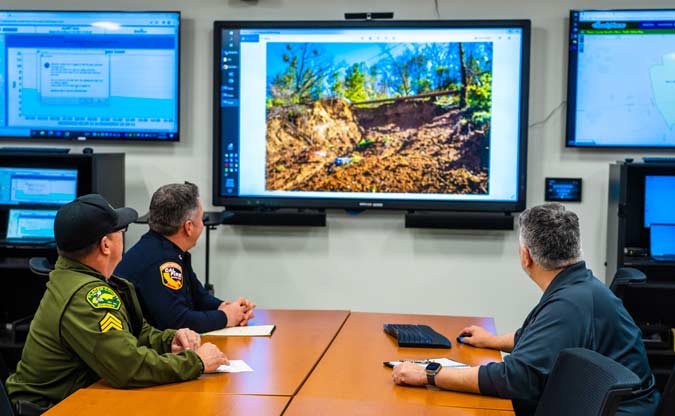Plans innovative model to manage emergency response and planning
Auburn, Calif. – With five declared emergencies in just two years, Placer County is now moving forward with a first-of-its-kind, emergency-response model that will enhance cooperation and coordination among the Placer County Sheriff’s Office, Placer County Fire, and the Placer County Office of Emergency Services.
Recently, a multi-disciplinary presentation detailing the new emergency-response model was provided to the Board of Supervisors by Placer County’s sheriff, fire and OES agencies. The plan calls for the addition of a dedicated sheriff’s lieutenant and assistant fire chief to work directly in the Office of Emergency Services and coordinate planning and disaster response alongside the OES team.
“It’s time for our county to take a stronger leadership role in this arena…”
Cindy Gustafson, District 5 Supervisor
Placer County Sheriff Wayne Woo says the idea of reorganizing OES was born after several unprecedented emergencies required a long and sustained response, such as the Mosquito Fire and Christmas Storm of 2021.
“Coordination is integral”
“This multi-agency approach will allow the sheriff’s office and its county partners to respond to emergencies more efficiently; coordination is integral during these critical incidents and having a dedicated position from the sheriff’s office embedded in the OES structure will allow plenty of time for planning and prevention work. While it will be a culture shift, I think the collaborative spirit already exists and we are positioned well to make this shift successful,” said Woo. “I am confident with the product that will come out of this team and confident we will become the model in the State of California that other counties will eventually look to emulate.”
Integration
Integrating these two new positions within OES will allow for enhanced emergency support, incident management, and pre-incident/emergency planning. These two positions will also provide support to OES outside of emergencies including the pursuit of grant opportunities, regional training and other areas as needed. The goals are centered around three focus areas: improved planning, enhanced public information along with heightened operational coordination.
“It’s imperative that we think outside of the box by creating a single point of contact within the Emergency Operations Center where we have dedicated command officers in place from both sheriff and fire to enhance coordination and communication during an active emergency,” said CAL FIRE/Placer County Fire Chief Brian Estes. “This model will also enhance recovery efforts and improve planning and preparedness programs as well as increase our competitiveness for grant funding.”
Law enforcement activities
The sheriff’s lieutenant will manage and direct the law enforcement activities of the EOC, coordinate law enforcement mutual aid, provide jurisdictional leadership for evacuation planning, and manage special teams for the sheriff’s office, including air operations, search and rescue and the dive team.
The PCF assistant chief will manage and direct the fire rescue activities of the EOC and provide administrative and operational management of the PCF/OES Hazardous Materials Response Team. The assistant chief will also provide jurisdictional collaboration in countywide evacuation planning and oversight of community preparedness and wildfire mitigation programs that are mandated by state law.
Mission
The mission is to foster a resilient and prepared Placer County through effective risk reduction efforts such as emergency preparedness training for county residents. This innovative approach would be the first known model of its kind in the State of California and would reinforce the county’s strategic priorities and multi-disciplinary commitment to emergency management.
“Community outreach and education are imperative to prepare our residents for emergencies because the government simply cannot do it alone,” said OES Assistant Director Dave Atkinson. “Additional resources will also help us to bolster training. We can plan all day long, but we need to make sure we train on our plans through exercises to ascertain their effectiveness and revise accordingly.”
Projected costs
The multi-agency model is estimated to cost $1.1 million for the first year and that allocation will cover building renovations and the purchase of additional emergency vehicles as well as the annual salary and benefits of the two new positions. The adoption of this multi-agency model will be finalized once funding is approved in the fiscal year 2023-24 budget. The ongoing annual cost after startup is anticipated to be $768,000 for salaries and benefits.
“This is exciting news. It’s time for our county to take a stronger leadership role in this arena and I am looking forward to solidifying this partnership with additional county support and resources,” said District 5 Supervisor Cindy Gustafson. “I’m pleased to hear that more evacuation planning is coming as it is a major concern among residents. I am confident we can do more to answer their questions and educate residents throughout the county about our response plans.”
The multi-agency model is also expected to be helpful when responding to mutual aid requests from other counties seeking assistance. The OES leads will be able to ascertain available resources more efficiently while ensuring adequate support remains in place for our own county.
related
- Placer County proclaims local emergency due to River Fire
- Mosquito Fire emergency shelter in Rocklin at Sierra College
- Placer County names new assistant director of the Office of Emergency Services
(21+ years strong)
Welcome to the brighter side!
Get in front of local customers! 24/7 (365)























